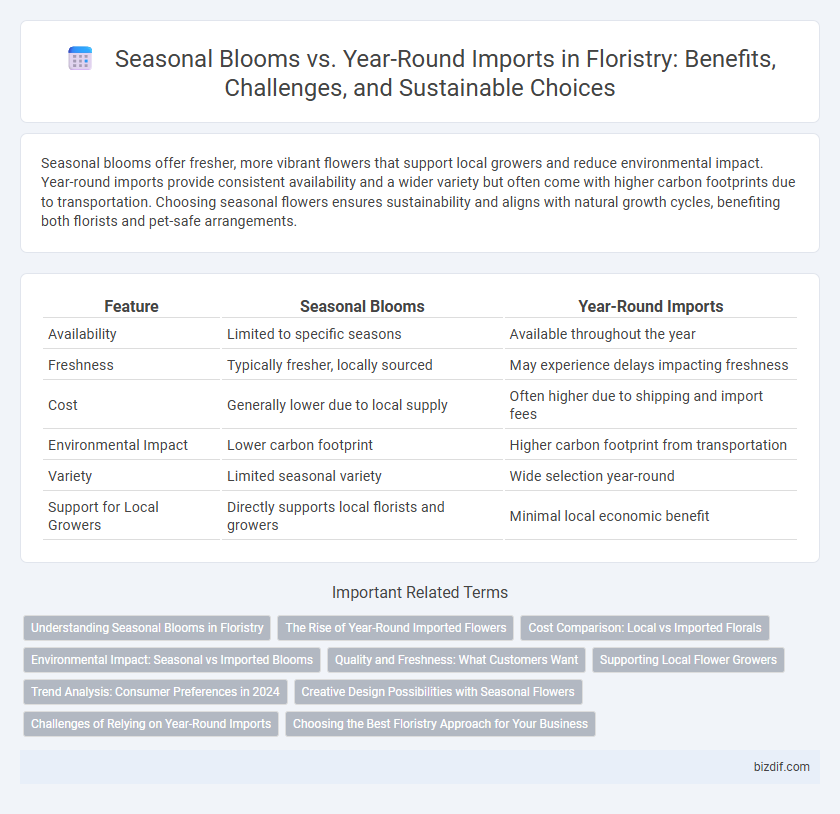Seasonal blooms offer fresher, more vibrant flowers that support local growers and reduce environmental impact. Year-round imports provide consistent availability and a wider variety but often come with higher carbon footprints due to transportation. Choosing seasonal flowers ensures sustainability and aligns with natural growth cycles, benefiting both florists and pet-safe arrangements.
Table of Comparison
| Feature | Seasonal Blooms | Year-Round Imports |
|---|---|---|
| Availability | Limited to specific seasons | Available throughout the year |
| Freshness | Typically fresher, locally sourced | May experience delays impacting freshness |
| Cost | Generally lower due to local supply | Often higher due to shipping and import fees |
| Environmental Impact | Lower carbon footprint | Higher carbon footprint from transportation |
| Variety | Limited seasonal variety | Wide selection year-round |
| Support for Local Growers | Directly supports local florists and growers | Minimal local economic benefit |
Understanding Seasonal Blooms in Floristry
Seasonal blooms in floristry offer vibrant freshness, enhanced fragrance, and eco-friendly benefits by aligning with local growing cycles and reducing transportation emissions. Understanding their natural availability helps florists create designs that highlight peak flower quality while supporting sustainable sourcing. Contrastingly, year-round imports provide consistent variety but often involve higher carbon footprints and potential compromises in bloom longevity.
The Rise of Year-Round Imported Flowers
Year-round imported flowers have surged in popularity due to their consistent availability, offering florists a diverse palette beyond the limitations of seasonal blooms. This global supply chain enables the import of exotic varieties and specialty flowers regardless of local climate constraints, supporting creative floral designs and meeting consumer demand for variety. The reliance on imports, however, raises sustainability concerns, emphasizing the need for balanced sourcing that considers environmental impact alongside aesthetic benefits.
Cost Comparison: Local vs Imported Florals
Seasonal blooms sourced locally generally offer a cost advantage due to reduced transportation and storage expenses compared to year-round imported florals, which often incur higher import tariffs and extended logistics fees. Local seasonal flowers typically maintain fresher quality, reducing waste and increasing value, while imported florals require temperature-controlled shipping and longer shelf life considerations that inflate costs. Florists balancing cost efficiency with product variety often find a strategic blend of seasonal local blooms and selective imports optimizes budgets and customer satisfaction.
Environmental Impact: Seasonal vs Imported Blooms
Seasonal blooms significantly reduce the environmental impact by minimizing carbon emissions associated with long-distance transportation and reducing the need for energy-intensive greenhouses. In contrast, year-round imported flowers often rely on extensive air freight and fossil fuel consumption, contributing to higher greenhouse gas emissions and resource depletion. Choosing locally grown seasonal flowers supports sustainable floristry practices and lowers the ecological footprint of floral arrangements.
Quality and Freshness: What Customers Want
Seasonal blooms offer superior quality and freshness due to their natural growing cycles and local availability, resulting in vibrant colors and longer vase life. Year-round imports often face delays in transit, compromising flower freshness and increasing the risk of damage, which can negatively impact customer satisfaction. Customers prioritize fresh, high-quality flowers that maintain their beauty longer, making locally sourced seasonal blooms the preferred choice for most floral arrangements.
Supporting Local Flower Growers
Seasonal blooms offer fresher, more vibrant flowers that support local flower growers and reduce environmental impact through lower transportation emissions. Embracing seasonal varieties helps sustain regional agriculture and promotes biodiversity by encouraging diverse crop cultivation. Prioritizing local blooms also ensures better quality and contributes directly to the local economy, contrasting with year-round imports that often involve longer supply chains and increased carbon footprints.
Trend Analysis: Consumer Preferences in 2024
Seasonal blooms continue to dominate consumer preferences in 2024 due to their freshness, sustainability, and connection to local ecosystems, driving higher demand in floristry markets. Year-round imports maintain a steady presence, favored for exotic varieties and consistent availability, but face increased scrutiny over carbon footprints and supply chain transparency. Trend analysis reveals a growing consumer shift toward eco-conscious purchasing, prioritizing native, seasonal flowers over imported alternatives to align with environmental values.
Creative Design Possibilities with Seasonal Flowers
Seasonal blooms offer unique textures, colors, and fragrances that inspire innovative floral arrangements reflecting the natural cycle of the year. Florists can leverage the limited availability of seasonal flowers like tulips in spring or chrysanthemums in autumn to create exclusive, vibrant designs that resonate with specific occasions. Year-round imports provide consistent supply but lack the authentic charm and variation that seasonal flowers bring to creative floristry projects.
Challenges of Relying on Year-Round Imports
Year-round imports in floristry often face challenges such as inconsistent quality due to varying climate conditions during transport and extended shelf life requirements. These imports can also lead to higher carbon footprints and increased costs compared to locally sourced seasonal blooms. Dependency on global supply chains introduces risks of delays and limited availability, affecting the reliability of floral arrangements.
Choosing the Best Floristry Approach for Your Business
Seasonal blooms offer fresher, locally sourced flowers that enhance sustainability and support regional growers, often appealing to eco-conscious customers. Year-round imports provide consistent availability of exotic varieties, helping florists maintain a diverse inventory regardless of seasonality. Balancing seasonal freshness with imported variety allows florists to optimize product quality, meet customer demand, and manage costs effectively.
Seasonal blooms vs year-round imports Infographic

 bizdif.com
bizdif.com